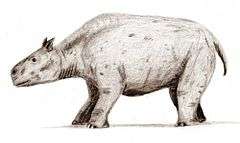Toxodontidae
| Toxodontidae Temporal range: Late Oligocene–late Pleistocene | |
|---|---|
 | |
| Toxodon platensis | |
| Scientific classification | |
| Kingdom: | Animalia |
| Phylum: | Chordata |
| Class: | Mammalia |
| Order: | †Notoungulata |
| Suborder: | †Toxodonta |
| Family: | †Toxodontidae Owen, 1845 |
| Subfamilies and Genera | |
|
Haplodontheriinae
†Nesodontinae
| |

Toxodontidae is an extinct family of notoungulate mammals known from the Oligocene through the Pleistocene of South America, with one genus, Mixotoxodon, also known from the Pleistocene of Central America and southwestern North America (Texas).[1] They somewhat resembled rhinoceroses, and had teeth with high crowns and open roots, suggesting that they often fed on tough pampas grass.[2] However, isotopic analyses have led to the conclusion that the most recent forms were grazing and browsing generalists.[3]
Classification
In 2014, a study identifying a new species of toxodontid resolved the families phylogenetic relations. The below cladogram was found by the study:[4]
| |
| ||||||||||||||||||||||||||||||||||||||||||||||||||||||||||||||||||||||||||||||||||||||||||||||||||||||||||||||||||||||||||||||||||||||||||||||||
| |
References
- ↑ E. Lundelius, et al. 2013. The first occurrence of a toxodont (Mammalia, Notoungulata) in the United States. Journal of Vertebrate Paleontology, Vol 33, No 1, pp. 229–232 DOI:10.1080/02724634.2012.711405
- ↑ Palmer, D., ed. (1999). The Marshall Illustrated Encyclopedia of Dinosaurs and Prehistoric Animals. London: Marshall Editions. p. 253. ISBN 1-84028-152-9.
- ↑ MacFadden, Bruce J. (September 2005). "Diet and habitat of toxodont megaherbivores (Mammalia, Notoungulata) from the late Quaternary of South and Central America". Quaternary Research. Elsevier. 64 (2): 113–124. Bibcode:2005QuRes..64..113M. doi:10.1016/j.yqres.2005.05.003.
- ↑ Forasiepi, A. A. M.; Cerdeño, E.; Bond, M.; Schmidt, G. I.; Naipauer, M.; Straehl, F. R.; Martinelli, A. N. G.; Garrido, A. C.; Schmitz, M. D.; Crowley, J. L. (2014). "New toxodontid (Notoungulata) from the Early Miocene of Mendoza, Argentina". Paläontologische Zeitschrift. doi:10.1007/s12542-014-0233-5.
- McKenna, Malcolm C., and Bell, Susan K. 1997. Classification of Mammals Above the Species Level. Columbia University Press, New York, 631 pp. ISBN 0-231-11013-8